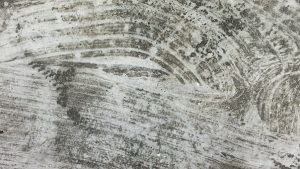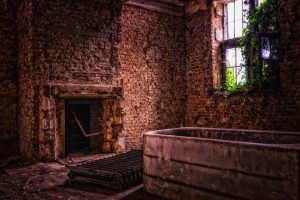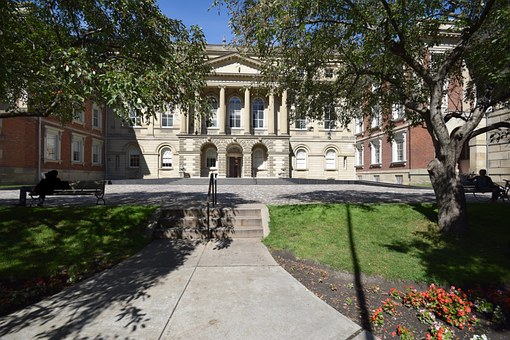Materials and Cleaning Methods
There are three main groups that masonry cleaning methods are usually divided into: abrasive, chemical, and water.
Water methods work to soften the soiling materials and dirt and then rinse the deposits away from a masonry surface. When chemical cleaning agents are used they react with paint, soiling material or dirt to remove them, and then water is used to rinse the masonry surface off. Abrasive methods include using sanding discs and grinders, and blasting with grit, which all mechanically remove paint, soiling material, or dirt (and some of the masonry surfaces as well, usually). Often a water rinse is used following an abrasive cleaning. Laser cleaning, although we will not be discussing in detail here, is another technique that conservators sometimes use for cleaning small historic masonry areas. However, it is expensive, so for a majority of historic masonry cleaning projects, it is usually not practical.
See also: Assessing Cleaning Treatments For Historic Buildings
 Although it might seem to go against common sense, you should carry out masonry cleaning projects by starting at the bottom and then working your way up to the top of the building, while keeping all of the surfaces wet that are underneath the area that is being cleaned. The reason for using this type of approach is based on the fact that cleaning effluent or dirty water dripping from cleaning above will leave streaks on dirty surfaces but won’t streak a clean surface if it is kept wet and then rinsed often.
Although it might seem to go against common sense, you should carry out masonry cleaning projects by starting at the bottom and then working your way up to the top of the building, while keeping all of the surfaces wet that are underneath the area that is being cleaned. The reason for using this type of approach is based on the fact that cleaning effluent or dirty water dripping from cleaning above will leave streaks on dirty surfaces but won’t streak a clean surface if it is kept wet and then rinsed often.
Water Cleaning
In general, the gentlest possible methods are water cleaning methods. They can safely be used to remove dirt from all kinds of historic masonry. Essentially there are four types of water-based methods: hot-pressurized water or steam cleaning; water washing with a non-ionic detergent supplement; pressure water washing; and soaking. After water cleaning is complete, it is frequently necessary to follow up by rinsing with water to wash the loosened soiling material off of the masonry.
*It might not be appropriate to use water cleaning methods on some masonry that is badly deteriorated since the water might exacerbate the deterioration, or on alabaster or gypsum, which in water are very soluble.
Chemical Cleaning
In general, chemical cleaners that are in proprietary product form, are another type of material that is used frequently for cleaning historic masonry. They can remove paint, other coatings, dirt, graffiti, as well as plant and metallic stains. Chemical cleaners that are used for removing soiling and dirt include organic compounds, alkalies, and acids. Of course, acidic cleaners should not be used on any acid sensitive masonry. Paint removers are based on organic solvents or other types of chemicals and are alkaline.
Chemical Cleaners for Removing Dirt
Both acidic and alkaline cleaning treatments include using water. Both of these types of cleaner are likely to also contain surfactant (or wetting agents), for facilitating the chemical reaction for removing dirt. Usually, the masonry is wet down first for both kinds of cleaners, and the chemical cleaner is then brushed on the surface or spray at very low pressure. The cleaner is then left on the masonry for whatever amount of time that the product manufacturer recommends, or, preferably, is determined through testing, and then is rinse off using a moderate or low-pressure cold water wash, or sometimes hot water is used.
It might be necessary to apply more than one application of cleaner, and it is a good practice to always test the recommendation of the product manufacturer regarding dwell times and dilution rates. Since every cleaning situation is unique, dwell times and dilution rates can vary greatly. The masonry surface can be lightly scrubbed with synthetic or natural bristle brushes before being rinsed. After it is rinsed, there should be pH strips applied to the surface to completely neutralize the masonry.
Acid-based cleaning products can be used on non-acid sensitivity masonry, and in general will include: concrete, cast stone, architectural unglazed terracotta, unglazed brick, slate, most sandstone, and granite. A majority of commercial acidic cleaners are primarily composed of hydrofluoric acid and often contains some phosphoric acid in order to prevent the development of rust-like stains on the masonry after it is cleaned. Acid cleaners are then applied to pre-wet masonry. The masonry needs to be kept wet while the acid is at “work” and then use a water wash to remove it.
On acid-sensitive masonry, an alkaline should be used, including on polished granite, architectural glazed terracotta, glazed brick, calcareous sandstone, unpolished and polished marble, and limestone. (Sometimes alkaline cleaners can also be used on non-acid sensitive masonry materials – after they have been tested first- but might not be as effective as they are when used on acid-sensitive masonry). There are two products that alkaline products are primarily made of: an alkali, like ammonium hydroxide or potassium hydroxide; and a non-ionic surfactant or detergent. Alkaline products, like acidic cleaners, are normally applied to pre-wet masonry, and then allowed to dwell, and finally, water is used to rinse it off. (A longer dwell time might be needed with alkaline cleaners compared to acidic cleaners). There are two extra steps that are needed following the initial rinse to remove an alkaline cleaner. First, a slightly acidic wash is given to the masonry – often using acetic acid in order to neutralize it, and it is then rinsed with water again.
Chemical Cleaners for Removing Paint, Other Coatings, Graffiti and Stains
 Removing paint, as well as some other types of coatings, graffiti, and stains are best achieved with cleaning compounds such as organic solvent paint removers, or alkaline paint removers. To remove paint layers from masonry surfaces normally involves applying the chemical cleaner using either a sprayer, roller, or brush, and then followed up with a water wash. Like with any form of chemical cleaning, any manufacturer’s recommendations on application procedure should be tested first before starting on the work.
Removing paint, as well as some other types of coatings, graffiti, and stains are best achieved with cleaning compounds such as organic solvent paint removers, or alkaline paint removers. To remove paint layers from masonry surfaces normally involves applying the chemical cleaner using either a sprayer, roller, or brush, and then followed up with a water wash. Like with any form of chemical cleaning, any manufacturer’s recommendations on application procedure should be tested first before starting on the work.
Usually, alkaline paint removers have the same composition that other types of alkaline cleaners do, and contain trisodium phosphate, ammonium hydroxide, or potassium. They are used for removing acrylic, latex, or oil paints, and effectively remove multiple paint layers. Alkaline cleaners might also remove certain water-repellent acrylic coatings. Like with other types of alkaline cleaners, a final water rinse and acidic neutralizing wash are usually needed after an alkaline paint remover has been used.
Organic solvent paint remover formulations vary and might include various combinations of solvents, which can include toluene, xylene, acetone, methanol, and methylene chloride.
Other Cleaners and Paint Removers
Other cleaning compounds that may be used for removing some painted graffiti and paint from historic masonry can include paint removers that are based on petroleum-based compounds or N-methyl-2-pyrrolidone (NMP). Removing stains, whether it is biological (fungal and plant) or metallic (copper or iron), or industrial (tar, grease, soot, and smoke) in origin, will depend on matching the kind of remover carefully to the specific type of stain. Removing stains successfully from historic masonry will frequently require applying a number of different types of removes before finding the right one. Removing paint layers off of a masonry surface usually will be achieved through applying the remover using a sprayer, roller, or brush followed up with a thorough water wash.

